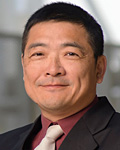Moore’s Law Extension and Beyond
Moore’s Law Extension and Beyond
-
 1. Moore's Law Extension and Beyo…
0
00:00/00:00
1. Moore's Law Extension and Beyo…
0
00:00/00:00 -
 2. Acknowledgement
408.34167500834167
00:00/00:00
2. Acknowledgement
408.34167500834167
00:00/00:00 -
 3. Acknowledgement
537.50417083750415
00:00/00:00
3. Acknowledgement
537.50417083750415
00:00/00:00 -
 4. Outline
577.877877877878
00:00/00:00
4. Outline
577.877877877878
00:00/00:00 -
 5. History of Computation
603.90390390390394
00:00/00:00
5. History of Computation
603.90390390390394
00:00/00:00 -
 6. Moore's Law in Microelectronic…
663.19652986319659
00:00/00:00
6. Moore's Law in Microelectronic…
663.19652986319659
00:00/00:00 -
 7. Power, Power, Power !
829.12912912912918
00:00/00:00
7. Power, Power, Power !
829.12912912912918
00:00/00:00 -
 8. Research on Moore's Law Extens…
910.643977310644
00:00/00:00
8. Research on Moore's Law Extens…
910.643977310644
00:00/00:00 -
 9. Why III-V MOSFET for Logic App…
1087.354020687354
00:00/00:00
9. Why III-V MOSFET for Logic App…
1087.354020687354
00:00/00:00 -
 10. Oxide layer formation on GaAs
1354.8214881548215
00:00/00:00
10. Oxide layer formation on GaAs
1354.8214881548215
00:00/00:00 -
 11. Ex-situ ALD high-k on III-V su…
1436.6366366366367
00:00/00:00
11. Ex-situ ALD high-k on III-V su…
1436.6366366366367
00:00/00:00 -
 12. ALD Al2O3 Process with TMA and…
1526.3263263263264
00:00/00:00
12. ALD Al2O3 Process with TMA and…
1526.3263263263264
00:00/00:00 -
 13. Highest ID in GaAs MOSFET enab…
1645.1117784451119
00:00/00:00
13. Highest ID in GaAs MOSFET enab…
1645.1117784451119
00:00/00:00 -
 14. First GaAs CMOS Inverter
1712.1788455121789
00:00/00:00
14. First GaAs CMOS Inverter
1712.1788455121789
00:00/00:00 -
 15. First GaAs CMOS based circuitr…
1745.3119786453121
00:00/00:00
15. First GaAs CMOS based circuitr…
1745.3119786453121
00:00/00:00 -
 16. First GaAs CMOS 5-Stage Ring-O…
1752.1521521521522
00:00/00:00
16. First GaAs CMOS 5-Stage Ring-O…
1752.1521521521522
00:00/00:00 -
 17. Research on Moore's Law Extens…
1801.901901901902
00:00/00:00
17. Research on Moore's Law Extens…
1801.901901901902
00:00/00:00 -
 18. 3D Transistors improve electro…
1826.3596930263598
00:00/00:00
18. 3D Transistors improve electro…
1826.3596930263598
00:00/00:00 -
 19. The First Transistor is on Ge …
1990.3236569903238
00:00/00:00
19. The First Transistor is on Ge …
1990.3236569903238
00:00/00:00 -
 20. Advanced Gate Structures (Gate…
2098.7320653987322
00:00/00:00
20. Advanced Gate Structures (Gate…
2098.7320653987322
00:00/00:00 -
 21. First Ge CMOS Circuits with 3D…
2151.6516516516517
00:00/00:00
21. First Ge CMOS Circuits with 3D…
2151.6516516516517
00:00/00:00 -
 22. Advanced Gate Structures
2281.2479145812481
00:00/00:00
22. Advanced Gate Structures
2281.2479145812481
00:00/00:00 -
 23. Research on Moore's Law Extens…
2329.9632966299632
00:00/00:00
23. Research on Moore's Law Extens…
2329.9632966299632
00:00/00:00 -
 24. Steep-slope Switches for Low-p…
2362.862862862863
00:00/00:00
24. Steep-slope Switches for Low-p…
2362.862862862863
00:00/00:00 -
 25. Steep-slope 2D NC-FETs
2468.0347013680348
00:00/00:00
25. Steep-slope 2D NC-FETs
2468.0347013680348
00:00/00:00 -
 26. Steep-slope MoS2 NC-FETs with …
2632.732732732733
00:00/00:00
26. Steep-slope MoS2 NC-FETs with …
2632.732732732733
00:00/00:00 -
 27. Negative DIBL and Negative Dif…
2735.1351351351354
00:00/00:00
27. Negative DIBL and Negative Dif…
2735.1351351351354
00:00/00:00 -
 28. Conclusions
2785.251918585252
00:00/00:00
28. Conclusions
2785.251918585252
00:00/00:00 -
 29. There are many rooms in-betwee…
2988.3883883883886
00:00/00:00
29. There are many rooms in-betwee…
2988.3883883883886
00:00/00:00
 Peide Ye is the Richard J. and Mary Jo Schwartz Professor of Electrical and Computer Engineering in the College of Engineering. He received his Bachelor of Science in electrical engineering in 1988 from Fudan University, Shanghai, China. Ye earned his PhD in condensed matter physics in 1996 from Max Planck Institute for Solid State Research in Stuttgart, Germany.
Peide Ye is the Richard J. and Mary Jo Schwartz Professor of Electrical and Computer Engineering in the College of Engineering. He received his Bachelor of Science in electrical engineering in 1988 from Fudan University, Shanghai, China. Ye earned his PhD in condensed matter physics in 1996 from Max Planck Institute for Solid State Research in Stuttgart, Germany.